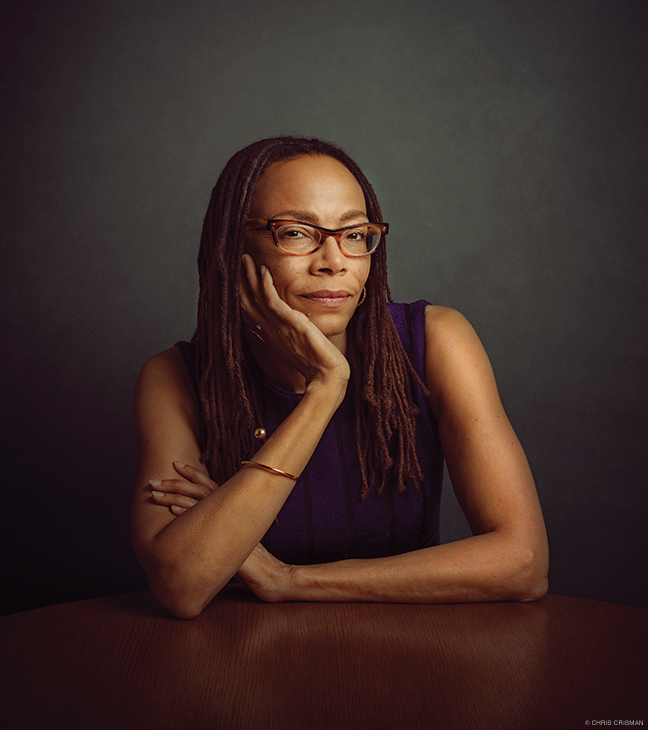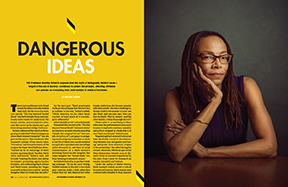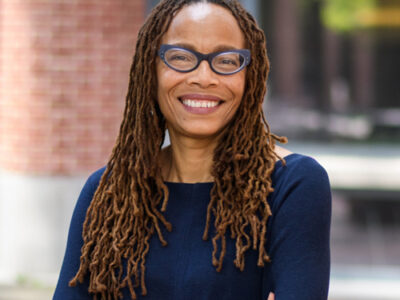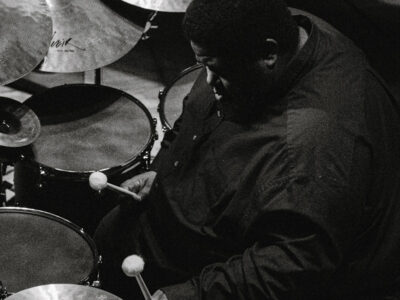
PIK Professor Dorothy Roberts exposes how the myth of biologically distinct races—forged in the era of slavery—continues to poison the present, affecting attitudes and policies on everything from child welfare to medical treatment.
BY MELISSA JACOBS | Photo by Chris Crisman C’03

There’s not much humor to be found around the subjects Dorothy Roberts deals with, but the Saturday Night Live parody, “The Day Beyoncé Turned Black,” was both bitingly funny and practically tailor-made for analysis by the lawyer, scholar, and social-justice advocate who serves as the University’s 14th Penn Integrates Knowledge Professor.
Roberts referenced the sketch at the beginning of a talk titled “What’s So Dangerous About Black Women’s Sexuality?” that she gave on February 17. That was shortly after Beyoncé’s release of her music video, “Formation,” and live performance of the song at the Super Bowl halftime show—“backed up by an entourage of black women sporting Black Panther Party Afros and berets,” Roberts said, and lyrically “saluting the Black Lives Matter movement, protesting against police brutality, and celebrating black culture and black beauty, including her ‘Negro nose with Jackson Five nostrils’ and her daughter Blue Ivy’s baby hair and Afro.”
For the most part, “black people were really proud and happy that Beyoncé was as militant as she was,” Roberts added. “White America, on the other hand, reacted—at least much of it reacted—quite differently.”
Which the folks at SNL took and ran with.
Formatted like a movie trailer, “The Day Beyoncé Turned Black” skewered whites’ assumptions around cultural ownership (“Maybe this song isn’t for us.” “But usually everything is!”), arrogance in assigning racial categories (a familiar co-worker isn’t black black; but a youth outfitted in a gold Africa pendant and camouflage jacket obviously is), and fears of racial contamination (in a white mother’s mounting horror as she imagines her tween daughter has “turned black,” too, from listening to Beyoncé’s music.)
But Roberts homed in on another revealing exchange: “To me the most telling, truthful moment in this skit is two white guys cowering under a desk, when they realize that not only Beyoncé but other female celebrities who become popular with white people—like Kerry Washington, the star of ABC’s very popular Scandal—are also black. And one man says, ‘How can they be black? They’re women.’ And the other shrieks, ‘I think they might be both!’
“That’s what is so terrifying to these white men: her performance is extra scary because it implicitly combines sexuality and politics wrapped in a body that is at once black and female,” Roberts said.
“Regulating black women’s bodies has been absolutely crucial to the relationship between race and gender and biology and power, from America’s origins to the present day,” she added during the lecture, which was offered as part of the Penn Humanities Forum’s 2015-16 thematic focus on sex and cosponsored by the Alice Paul Center for Research on Gender, Sexuality and Women.
“Under the system of chattel slavery, black women’s bodies served a critical bio-political function. Black women were commercially valuable to their masters not only for their labor, but also for their ability to produce more enslaved property for them. Whites could maintain their domination and increase their wealth by devising a legal and political apparatus that gave them control over black women’s sexuality and childbearing. An oppressive apparatus centered on black women’s bodies. It was—and is still—the linchpin of the system of white supremacist, capitalist patriarchy.”
Attitudes rooted in the era of slavery and colonialism—when the concept of a racial hierarchy was being constructed by white Europeans—continue to resonate powerfully in the present, Roberts says. In numerous articles, academic presentations, and media appearances, and her books, Killing the Black Body: Race, Reproduction, and the Meaning of Liberty, published in 1998, and Shattered Bonds: The Color of Child Welfare in 2001, she has offered a scathing critique of how they have shaped popular images demonizing black women and led to brutally unfair policies on poverty, child welfare, and reproductive rights. More recently, with 2011’s Fatal Invention: How Science, Politics, and Big Business Re-Create Race in the Twenty-first Century, she extended her analysis to look at their continuing pernicious effects in our own “genomic age,” including on healthcare policy, scientific research, and decisions about appropriate medical treatment. (Read an excerpt from Fatal Invention: How Science, Politics, and Big Business Re-Create Race in the Twenty-first Century.)
When Roberts joined the University in 2012 as the first black woman PIK Professor, Penn President Amy Gutmann praised her as “an award-winning teacher and scholar who writes and speaks about some of the most important and challenging issues facing our society, including civil rights, reproductive rights, poverty, child welfare and family law,” and whose work “blends perspectives from law, sociology, ethics, race and gender studies, and beyond.”
Roberts is the George A. Weiss Professor of Law and Sociology, the Raymond Pace & Sadie Tanner Mossell Alexander Professor of Civil Rights, and professor of Africana Studies. She is also the founding director of the Program on Race, Science, and Society (PRSS) in the School of Arts and Sciences, which, its website notes, is “devoted to transformative and interdisciplinary approaches to the role of race in scientific research and biotechnical innovations, aiming both to promote social justice and to dispel the myth that race is a natural division of human beings.”
In her two PHF lectures—she gave a second one on February 24—Roberts addressed the “interlocking systems of oppression” that affect black women, and talked about black feminists’ efforts to counter them.
“The sexual violation of enslaved women and girls set a long-lasting foundation for contemporary notions about black female sexuality,” Roberts said. “This legacy of sexual and reproductive violence has been preserved over the centuries by a repertoire of degrading images designed to legitimize white men’s immorality—images that paint black women as innately prone to having unrestrained sex, procreating recklessly, and then passing down a degrading lifestyle to their children.”
From the time of slavery—when black women were portrayed as bad, detached mothers to justify selling their children—such images have morphed into the “mythical welfare queen” of the 1980s and the uncaring, drug-addicted mothers of “crack babies” in the 1990s. “Politicians, policymakers, sociologists, demographers, public health experts, epidemiologists, the media—all cast black women’s sexuality as an urgent social problem,” Roberts said. “They routinely circulate these icons of black female sexual irresponsibility to support birth control, welfare reform, foster care, and law-enforcement policies that punish black women’s sexual and child-bearing decisions.”
Taking black children from their black mothers “is a way of dealing with struggling families in this country, an alternative to generously supporting [them], especially single mothers,” Roberts said, and has been a factor in calls for “legislation that would make it easier to terminate parents’ rights so that these children can be available for adoption.”
While she’s not against transracial adoption, Roberts does oppose “arguments to free black children from their supposedly bad mothers so that they can be adopted by white middle-class families, made even by white women who claim to be feminists. It would be such a stronger movement if those women joined with black mothers for a stronger system of supporting families and reducing or even abolishing foster care as we know it.”
US laws and social policies continue to infringe on black women’s reproductive rights in an effort to control, or restrict, the number of children they have, according to Roberts. Fighting against that system is the goal of the reproductive-justice movement, which she describes as “an approach to reproductive health and freedom that takes into account the context in which people make reproductive decisions, including the intersecting oppressions that women face in controlling their reproductive lives.”
The concept of choice can be a cruel fiction for poor women. Many can’t afford abortions, Roberts says, and if they want to maintain their pregnancies, they don’t have access to high-quality prenatal care or public support for their care giving. Reproductive justice would remedy the social inequities that affect poor women’s childbearing decisions.
But organizations like Planned Parenthood and NARAL have neglected the full range of reproductive health needs of poor women of color, Roberts charges. “Historically, white women-led organizations have not given an equal voice to women of color and the interests and concerns that sometimes diverge from white women’s interests and concerns,” she says. “White middle-class women have been fighting for reproductive rights that affect their own lives, not necessarily those that impact black women.”
To show how abortion rights is only one aspect of reproductive justice, Roberts talks about policies that seek to deter poor women from having children. She cites child-exclusion policies that deny increased benefits to women who have additional children while already receiving welfare. America’s long—and, says Roberts, lingering—history of coercive sterilization (tubal ligation or hysterectomies performed without informed consent) is another example. “This ideology—which I call a eugenicist ideology—that sterilizing poor, black women is the answer to not only black poverty but poverty in America, that it will save taxpayer money, is still circulating and is having real social consequences,” she said.
“One traditional means of doing that was to condition welfare or healthcare benefits on agreeing to sterilization, which is not voluntary consent,” she elaborates in an interview. “For example, doctors have told women that they will not perform an abortion unless the woman signs a consent to sterilization. Thousands of black and Latina women were pressured to sign a consent for sterilization during labor or were misdiagnosed with a condition that requires a hysterectomy when the same symptoms were treated differently in white women. There’s also evidence that white women who seek sterilization are often discouraged from it or even refused the procedure.”
Reproductive justice aims at ending forced or coerced sterilization and giving poor women free access to all forms of birth control. With regard to the latter, Roberts points to programs that encourage at-risk black and Latina teenagers to use long-acting implants rather than the Pill or condoms.
“It’s unethical to identify a group of teenagers and encourage them to use a particular form of birth control simply because of their race and class,” Roberts says. Aside from the implicit assumption that these teens can’t be trusted to responsibly use other methods, “it’s also based on the idea that it’s important for these teenagers in particular not to have children in order to increase their opportunities,” Roberts adds. “It’s seen as more of a harm for ‘at-risk’ teenagers to have children than for, say, a white middle-class teenager. Getting at-risk teenagers to use long-acting birth control is being promoted instead of asking why they have fewer opportunities in the first place.
“These policies often divert attention from the structural forces that put black girls at a disadvantage and instead focus on birth control as the answer. A central premise of reproductive justice is that birth control should be a means to give people control over their lives. Don’t turn to birth control to solve social problems caused by structural inequities. When government looks to it to solve social problems, it often is used as a way of manipulating and regulating women.”
“Race is not a biological category that is politically charged,” Roberts writes in the preface to Fatal Invention. “It is a political category that has been disguised as a biological one.”
The claim that humans can be separated into biologically different races was first formulated by white Europeans as a way to justify owning black people as property, Roberts writes. Slavery has existed for millennia, but the condition was never considered immutable, or fundamental to the nature of a given group. Early on in Britain’s American colonies, blacks were treated similarly to white indentured servants, who then comprised up to two-thirds of immigrants to the New World. But that changed as white and black laborers made common cause in revolts like Bacon’s Rebellion in Virginia in 1676, leading to an increase in the importation of slaves from Africa and actions to “drive an impenetrable wedge” between them and their white counterparts. By 1700, Roberts writes, “Africans were treated as a distinctly different kind of slave: they were made into the actual property of their masters, a lifelong bondage that passed down to their children …
“As officials split white indenture from black enslavement and established ‘white,’ ‘Negro,’ and ‘Indian’ as distinct legal categories, race was literally manufactured by law,” she adds, concluding, “Colonial landowners inherited slavery as an ancient practice, but they invented race as a modern system of power.”
Roberts describes how this happened in tandem with a “shift among European intellectuals from theological to biological thinking.” She catalogues some telling examples from the Enlightenment’s penchant for taxonomy—from Linnaeus’s four-part division of Homo sapiens, with europaeus on top and afer at the bottom; to Louis Agassiz’s insistence that “degraded and degenerate” blacks must have been created as a different species; to Penn’s own Samuel George Morton M1820 and his Crania Americana, which ranked races by skull size.“[N]aturalists made race an object of scientific study and made European conquest and enslavement of foreign peoples seem in line with nature,” Roberts writes. “The insistence on finding differences among people so they can be categorized governs the study of human biology to this day.”
Darwin’s theory of natural selection, and the twisting of his ideas into Social Darwinism, along with the rise of the (quite mainstream) eugenics movement at the turn of the 20th century, all served to further popularize the notion of racial hierarchies that reinforced the reigning social order. The horrors of Nazi Germany threw such notions out of favor—but only temporarily. When UNESCO issued a statement in 1950 from a panel of international experts determining that race “is not so much a biological phenomenon as a social myth” and rejecting ideas about racial superiority, Roberts writes, criticism from physical anthropologists and geneticists was so fierce that it was withdrawn in favor of a much more qualified statement issued the following year that rejected racism but supported the study of racial differences and left open the possibility of deficiencies in “innate capacity” among them.
If anything could have put such views to rest, you’d think it would be the Human Genome Project. After all, when President Bill Clinton announced the success of the project in 1999, he plainly said, “I believe one of the great truths to emerge from this triumphant expedition inside the human genome is that in genetic terms, all human beings, regardless of race, are more than 99.9 percent the same,” and his comments were echoed by project leaders Francis Collins and Craig Venter. But in fact, as Roberts details throughout Fatal Invention, “just the opposite” occurred: “scientists are using genomic theories and technologies to create a new racial science that claims to divide the human species into natural groups without the taint of racism.”
“The concept of biological races is deeply embedded in every single institution and aspect of culture in our society,” Roberts said at the PHF. Eradicating it “requires simultaneously educating people about the true meaning of humanity, that we are not naturally divided into races, and also concrete social changes that promote racial equality, such as ending mass incarceration, ending unjust policies about reproductive health, and ending the stereotypes and policies that reinforce the view that race is a natural division and make them seem acceptable.”
A major focus of Fatal Invention is how such thinking shapes scientific research and medical treatment in multiple ways, with sometimes-disastrous results and doubtful benefits. Roberts cites a case where a little girl suffered through years of misdiagnoses because her doctors were apparently convinced that blacks never had cystic fibrosis (someone finally looked at her X-rays without knowing who the patient was), and the equally mistaken belief that only blacks contract sickle-cell disease. Another misconception—once articulated by no less an authority than Oprah, and approved by Dr. Oz on her show, Roberts reports—is that blacks are prone to hypertension because Africans who could retain more salt in their bodies were most likely to survive the Middle Passage to America in slave ships.
But more than anecdotal tales, Roberts emphasizes how grouping people by race is harmful on two counts (at least). First, physical appearance or self-identification is a very poor indicator for an individual’s actual genetic makeup. Second, statistical differences between groups are dwarfed by differences across the population. (The greatest genetic diversity is found on the African continent, Roberts notes, for the simple reason that people have been living there the longest.) For example, referring to a recommendation that Asians receive a lower initial dose of the statin Crestor because research subjects of Asian origin showed an increased risk of muscle damage, Roberts points out that at least some whites, Hispanics, and blacks will have a similar genotype to the Asians adversely affected. “Rather than prescribing by race, we should ask why Crestor is usually prescribed at a dose known to have catastrophic side effects.”
This past February, Roberts co-authored a piece in the journal Science that called for ending the use of racial terminology in scientific journals and professional societies in favor of terms such as “ancestry” or “population.” Written with fellow PIK Professor Sarah Tishkoff, the David and Lyn Silfen Professor in Genetics and Biology; Drexel University public-health professor and PRSS board member Michael Yudell; and Rob DeSalle, a curator of entomology at the American Museum of Natural History, the paper stressed that ancestry is “a statement about an individual’s relationship to other individuals in their genealogical history; thus, it is a very personal understanding of one’s genomic heritage,” while the concept of race “has led scientists and laypersons alike to draw conclusions about hierarchical organization of humans, which connect an individual to a larger preconceived geographically circumscribed or socially constructed group.”
Despite the fact that social scientists have been pointing out that the use of racial categories is problematic for several decades, the authors noted, even well known experts continue to use inexact terms like black and Hispanic. “It is preferable to refer to geographic ancestry, culture, socioeconomic status, and language, among other variables, depending on the questions being addressed,” Roberts and her colleagues wrote, “to untangle the complicated relationship between humans, their evolutionary history, and their health.”
In April Roberts and Tishkoff were awarded a grant from the Fels Research Policy Initiative at Penn to study the global impact of race in biomedicine and the social inequities that contribute to it. And Roberts has continued to speak out on the issue, as in a recent appearance on the PBS News Hour responding to a survey of 500 respondents—including 400 medical students—that showed widespread belief that black people felt less pain and even had thicker skin than whites, leading to under-treatment for pain.
While broad societal myths and assumptions played a role, Roberts said, such ideas are “deeply rooted and fundamental to the way medical education works in the United States: students are taught to notice the race of their patients, to treat their patients differently because of race, and they’re taught that that’s because of fundamental biological differences between people of different races.”
She called on medical educators to help students understand that disparate health outcomes between races are the result of social inequality. “This study points out how dangerous it is to continue to teach medical students that race is a biological category that produces these differences in health or experience of pain based on biological differences between the races,” she said.
Roberts dedicated Fatal Invention to her parents, “Iris and Robert Roberts, who taught me that there is only one human race.”
The fact that her parents’ marriage was an interracial one—Iris was black, Robert white—comes up a few times in the book, as Roberts quizzes various researchers about the (mis)use of racial categories in their work.
Her latest project will focus specifically on the topic of interracial marriage, through her parents’ relationship and a trove of interviews that the two of them—both anthropologists—conducted with other interracial couples over 30 years for a planned book project that never came to fruition.
Roberts inherited 25 boxes of research files when her father died in 2001, but was busy writing two books on more urgent topics, she says. In the last two years, she decided to begin exploring the unique archive and write her own book about the black-white couples her parents interviewed, her parents’ mission to promote interracial marriage, and the surrounding racial politics in Chicago.
Roberts’ father earned his doctorate at the University of Chicago, while working as a lecturer at Roosevelt University. He became a professor at Roosevelt, chairing the anthropology-sociology department, and also held visiting professorships in several foreign locations. Her mother, originally from Jamaica, was a student at the school, and they met when she became his research assistant.
They married in 1954. Shortly after Roberts’ birth in 1956, the family traveled to Liberia—where her twin sisters were born—returning to Chicago when Roberts was two. It was just one of several trips her parents took for anthropological research and to school their children in multiculturalism. Foreign exchange students also often lived in the family’s home in the city’s Hyde Park neighborhood, and Roberts remembers frequent trips to the Field Museum of Natural History and the University of Chicago’s International House.
“My parents had a strong sense that all human beings are equal and can live harmoniously and peacefully together,” Roberts says. “They were not so much civil rights advocates as human rights advocates. My very early childhood was deliberately focused on human equality.”
As a kindergartner, Roberts recalls, she embraced her parents’ philosophy. “I remember being proud that I had parents of different races and that was an important part of my identity. But by the time I was in seventh grade, I identified as black and was much more interested in liberation for black people than in interracial relationships,” she says. “Until extremely recently, I really diminished the fact that my parents were black and white. Most people think of me as black. I don’t identify as biracial or mixed race.”
The limits of interracial harmony were evident in Roberts’ extended family. While she and her sisters were very close to their mother’s family, they were estranged from most of her father’s side. Roberts thinks that her father may have waited until his parents died to marry her mother. One of her father’s brothers disowned him and the other visited infrequently. “That also increases the mystery for me of how my father became so much more open-minded than his brothers,” she says.
The racial-political tumult of the 1960s probably also played a role in her self-identification. By age 12, Roberts started attending political meetings in Chicago, writing passionate essays about civil rights and leafletting for Eugene McCarthy, who was challenging Lyndon Johnson for the 1968 Democratic presidential nomination.
Her political consciousness continued to develop during her undergraduate years at Yale. It was the height of the anti-war and women’s-liberation movements, and civil rights were a constant backdrop. “Even though I’d always been very interested in social justice issues and participated from a distance in civil rights issues as a child, it was really in college where I began to feel a stronger sense of the significance of being a black person,” she says.
Roberts followed in her parents’ footsteps by majoring in anthropology at Yale, but diverged from their path to pursue a law degree at Harvard afterward. Graduating in 1980, she practiced law for most of the following decade, joining Paul, Weiss, Rifkind, Wharton & Garrison in Manhattan. Roberts had three children while working there as a litigation associate. While the firm had a paid maternity leave policy, it was unheard of for female associates to use it. Roberts realized how difficult it was for women with far less support than she had to raise children while holding down a job.
Affordable, high quality child care is one of the tenets of reproductive justice; Roberts advocates for that and paid family leave. “Why isn’t there a massive movement by women and all caregivers in this country?” she asked in her lecture. “We don’t have enough child care. Everyone is struggling to find adequate child care, even professors here [at Penn].”
In 1988, Roberts left the firm to move into academe, “which is what I always wanted to do,” she says. “I had become interested in the reproductive rights of black women, and I was itching to get into research and teaching.” She taught at Rutgers Law School from 1988 to 1998, then joined the law school faculty at Northwestern, serving as the Kirkland & Ellis Professor from 2002 until 2012, when she came to Penn.
Her new project represents a departure from Roberts’ previous work. She’ll be putting her parents, their marriage and their work on display for the world to see. She’s now reading through the many pages of transcripts from their interviews with those interracial couples, conducted between 1937 and 1967, and gleaning clues about the origin of her parents’ professional and romantic relationship. “My father began [this project] when he was 22, more than a decade before he met my mother,” she says. “But during the 1950s, they were interviewing couples together, before they got married. Then at some point they became a romantic couple. I’m trying to figure out their motivations and the timeline. How did my father get interested in interracial marriage when he was 22 years old?”
But mostly, she’s coming to terms with the differences between her parents’ philosophies about race and her own—and with what they have in common. “My father thought that if we could live intimately with each other that we would recognize our common humanity,” Roberts says. “But that’s insufficient, because it assumes that people will get to know and value one another without the structural changes that are essential. Black and white people lived in close quarters on plantations during slavery. That didn’t create racial equality. What was needed was the abolition of slavery.”
While Roberts grapples with her parents’ legacy, she shares their most basic belief and has spent her career furthering it. “Deep down, fundamentally, what I am arguing for and working toward is a real recognition of everyone’s humanity,” she says. “I credit my parents for giving me that philosophy.”
Melissa Jacobs C’92 writes frequently for the Gazette.
EXCERPT
Second-Class Treatment
The impact of second-class treatment on black people’s bodies is devastating. It is manifested not only in the black-white death gap but also in the drastic measures required when chronic disease is left unmanaged. Black patients are less likely than whites to be referred to kidney and liver transplant wait lists and are more likely to die while waiting for a transplant. If they are lucky enough to get a donated kidney or liver, blacks are sicker than whites at the time of transplantation and less likely to survive afterward. “Take a look at all the black amputees,” said a caller to a radio show I was speaking on, identifying the remarkable numbers of people with amputated legs you see in poor black communities as a sign of health inequities. According to a 2008 nationwide study of Medicare claims, whites in Louisiana and Mississippi have a higher rate of leg amputation than in other states, but the rate for blacks is five times higher than for whites. An earlier study of Medicare services found that physicians were less likely to treat their black patients with aggressive, curative therapies such as hospitalization for heart disease, coronary artery bypass surgery, coronary angioplasty, and hip-fracture repair. But there were two surgeries that blacks were far more likely to undergo than whites: amputation of a lower limb and removal of the testicles to treat prostate cancer. Blacks are less likely to get desirable medical interventions and more likely to get undesirable interventions that good medical care would avoid.
From Fatal Invention: How Science, Politics, and Big Business Re-Create Race in the Twenty-first Century, by Dorothy Roberts, The New Press, 2011.




